What is Meniscus?
The meniscus is a wedge-shaped fibro-cartilaginous tissue that separates the thigh bone (femur) from the shin bone (tibia). Each knee joint has a medial meniscus and a lateral meniscus. The meniscus acts as “shock absorbers” between the thigh bone and shin bone. As we walk, run, and jump the knee absorbs these tremendous forces.
The wedge shape assists in rotational stability. The medial meniscus is much less mobile than the lateral and it cannot as easily accommodate abnormal stress. This may be why meniscal lesions are more common on the medial side than the lateral side.
Role of the Meniscus :
- Improving articular congruency and increasing the stability of the joint.
- Controlling the complex rolling and gliding movements of the joint, and
- Distributing load during movement
In adult people, Meniscus Tear is usually the result of trauma, contact sports like soccer players are more likely to suffer from meniscal injuries.
Even in the absence of injury, there is gradual stiffening and degeneration of the menisci with age, so splits and tears are more likely in elderly life, particularly if there is associated arthritis.
Meniscus Tear
The meniscus consists mainly of circumferential fibers held by a few radial strands. It is, therefore more likely to tear along its length than across its width.
Mechanism of injury:
The split is usually initiated by a rotational grinding force which occurs when the knee is flexed and twisted while taking weight. Hence it’s common in contact sports like soccer, rugby, etc.
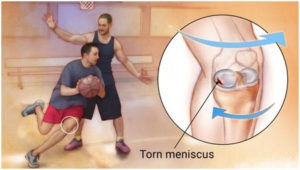
Pathology
In 75%, the split is vertical along the length of the meniscus. If the separated fragment remains attached to the ends (anteriorly and posteriorly), the lesion is called “bucket handle tear”. The torn portion at times is displaced towards the center of the joint and causes jamming between the thigh bone and shin bone (a blockage to extension) often referred to as “locking”. If the tear appears at one of the end edges of the meniscus like a tongue, if it is anteriorly it is known as an “anterior horn tear “ and if posteriorly it is known as a “posterior horn tear”.
Horizontal tears are less common and are a result of minor repetitive trauma. These tears are degenerative in nature ate mostly associated with meniscal cysts.
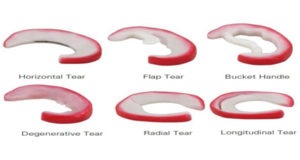
Most of the portion of the meniscus is avascular (white zone) and spontaneous repair doesn’t occur unless the tear is in the outer third (red zone), which is vascularized from the attached synovium and capsule.
The loose fragment acts as a mechanical irritant and can give rise to recurrent synovial effusion and in some cases, secondary osteoarthritis.
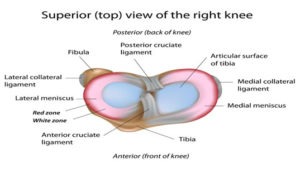
Symptoms of a Meniscus Tear
- A patient is usually a young person who sustained a twisting injury to the knee while playing.
- Pain (usually on the medial side) is often severe and further activity is avoided.
- Occasionally the knee is locked in partial flexion.
- Almost invariably swelling appears some hours later, or perhaps the following day.
- With rest, the initial symptoms subside only to recur periodically after trivial twists or strains. Sometimes the knee “gives way” spontaneously and this is again followed by pain and swelling.
- In patients aged above 40 years, the initial injury may be unremarkable and the main complaint is of recurrent “giving way” or “locking”.
On examination, the knee may be held in slight flexion and there is often slight effusion. In long-standing cases, the quadriceps will be wasted. Tenderness is localized to the joint line, in most patients on the medial side. Flexion is often full but an extension is often slightly limited.
Apley’s grinding test and McMurry’s test can be used to identify a meniscal tear.
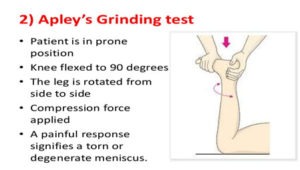
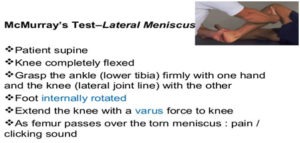
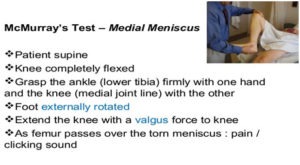
Investigations:
Plain x-rays are usually normal. MRI is the most reliable method of confirming the diagnosis. Arthroscopy has the advantage that, if a lesion is identified it can be treated at the same time.
Treatment of Meniscus Tear
A small meniscus tear, or a tear in the red zone, will usually respond quickly to physiotherapy treatment.
Researchers have discovered that if the strengthening of leg muscles is done adequately, the bone stresses reduce and the knee becomes more dynamically stable. This can be achieved through physiotherapy treatment.
Aims of physiotherapy treatment:
- Control pain and inflammation.
- Achieve a full joint range of motion.
- Strengthening of muscles around the knee: especially quadriceps and hamstrings.
- Strengthening of lower limb muscles: calves, hip, and pelvis muscles.
- Improve patellofemoral alignment.
- Proprioception and balance training.
- Prevention of reoccurrence
Meniscal injuries are commonly associated with other knee injuries, which need to be treated in conjunction with your meniscal tear. Meniscal tear commonly takes six or eight weeks to fully heal. As mentioned previously, some meniscal tears may require surgery. It is important to avoid activities and exercises that place excessive stress on the meniscus and further delay healing. In some cases, physiotherapists may advise partial on no weight-bearing. In such instances, crutches may be recommended.
Surgery
Most surgeons will recommend a few weeks of physiotherapy treatment prior to contemplating surgery.
Benefits of Pre-Operative Physiotherapy:
- In most cases, a patient shows great recovery and is successfully rehabilitated without surgery.
- Strengthening the knee for better preparation of post-operative rehabilitation.
Surgery is usually performed arthroscopically to either resect (remove) the torn fragment or repair (stitch) a tear in the outer zone.

Post-Surgical Physiotherapy for Meniscal surgery
- Resected Meniscus Tears
Physiotherapy rehabilitation for resected meniscal tears is usually aggressive, targeting an early return to function. The patient is progressed through rehabilitation as pain and swelling subside. These patients normally return to function within 3 to 6 weeks.
- Post-Meniscal Repair
Rehabilitation after a meniscus repair usually differs from a resected surgery due to the healing time required to heal up the stitched meniscus. The patient is on non-weight bearing for 4 to 8 weeks to allow the meniscus to heal before commencing weight-bearing exercises.
Physiotherapy rehabilitation should focus on early mobilization of the knee joints and strengthening of quadriceps, hamstrings, and leg muscles.
Treatment guidelines will be similar to the non-operative approach taking into consideration the findings and operative procedures performed.
For more specific information, consult a physiotherapist at PAIN FREE PHYSIOTHERAPY CLINIC.





